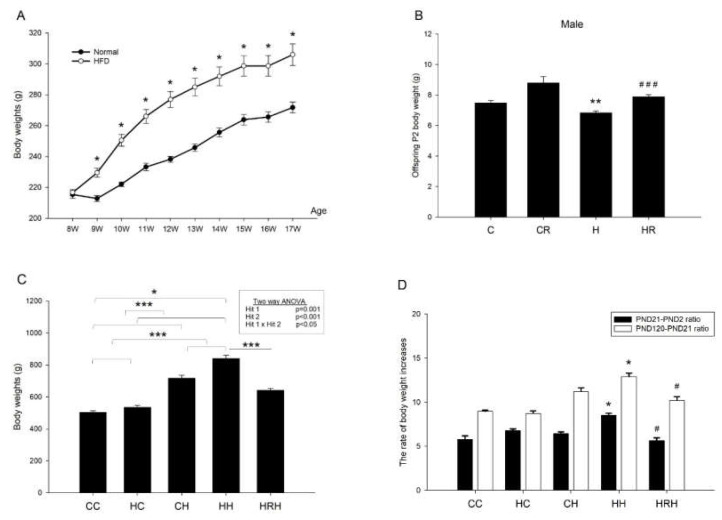Figure 3.
Body weight. (A) Female rats were fed a chow diet or a high-fat diet (HFD) and weighed weekly for 8 weeks before mating. n = 10–12 for each group. Student’s t-test, * p < 0.05 vs. HFD; (B) After mating, male pups were weighed on PND 2. F (3,92) = 16.075, p < 0.0001. n = 10–12 for each group. ** p < 0.01 vs. C; ### p < 0.001 vs. H. One-way ANOVA followed by Fisher’s LSD post hoc was used to assess the significant differences among groups and multiple comparisons. (C) The offspring were weaned at 21 days of age and allocated to either the chow diet or HFD ad libitum from weaning up to ~4 months of age. The male rats were weighed at ~4 months old. Body weights were analyzed using two-way ANOVA (maternal diet x post-weaning diet). The therapeutic effect of resveratrol was evaluated using the Student t-test. Maternal HFD/obesity: (F (1,53) = 12.131, p = 0.001). Postnatal HFD: (F (1,53) = 122.205, p < 0.001). An interaction effect between maternal HFD/obesity and postnatal HFD: (F (1,53) = 4.768, p < 0.05). Hit 1 indicated CC and CH vs. HC and HH. Hit 2 indicated CC and HC vs. CH and HH. * p < 0.05; *** p < 0.001. (D) At PND 21, the ratio of body weight increases was highest in the HH group (compared with PND 2; * HH vs. CC, CH, and HC, all p < 0.05; # HH vs. HRH; p < 0.05). At ~PND 120, the ratio of body weight increases was highest in the HH group (compared with PND 21; * HH vs. CC, CH, and HC, all p < 0.05; # HH vs. HRH; p < 0.05). n = 10–12 for each group. HFD: high-fat diet; PND: postnatal day.

